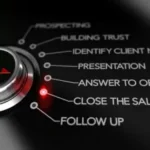What is an objection?
Master sales trainer, J Douglas Edwards, arguably the world’s best ever Sales and Persuasion Trainer said “Objections, if you learn to listen, will indicate to you what they want to buy. Objections are in effect, signposts on the way to the sale. That is, if you learn to listen. You see, if it wasn’t of concern, they wouldn’t object. Understand that these objections are telling you what they want to buy. The thing that you got to understand is that nobody wants to buy your product or service. I don’t care what the product or service is, nobody wants to buy it. They only want what the product will do for them. They don’t want to buy what it is, they want to buy what it will do.”
“An objection is also a reason for not buying that arises out of your prospects lack of understanding, and is usually based on insufficient information.”
You see a good salesperson can handle any objection. Well, the very fact that he or she can handle it means that if it does come up, it came up because these people did not fully understand, so it’s lack of understanding, and a request to know more”
“The smart salesperson looks for objections, and they red flag them….Because that’s what the customers are going to buy on. This is the true interest “
How do you handle objections? Below is the time tested and easily learned 9 step easy process for managing all sales objections:
Step 1 Objection comes….Be prepared
Step 2 Ignore it… Bypass it
Step 3 Objection reappears….Acknowledge it… Empathise
Step 4 Mirror the objection back
Step 5 Permission technique
Step 6 Question it
Step 7 Obtain their answer
Step 8 Obtain final clarification
Step 9 Do the paperwork or get another objection and go back to step number three
9 winning steps to managing all sales objections
Step 1 OBJECTION COMES
As a professional salesperson, you should be glad that you’re getting sales objections. It shows that the customer is interested. They are buying signals. Be prepared. Learn your lines. Remember….Objections are good, not bad
Step 2 BYPASS IT
Most of us have a tendency, when we first hear an objection, is to answer it. We suggest when you hear an objection, you never answer it….You bypass it.
- “Thank you .With your okay, I’ll deal with that a little later.”
- “Yes, I can see why you feel that way. As I said….”
- “That’s a really good point. Can we come back to that in just a few moments?”
If the objection reappears, go to step three.
Step 3 OBJECTION RE-APPEARS… Acknowledge it…. Empathise
Some really good lines to use are as below
- “I can see your point….”
- “I can understand that….”
- “I’m glad you brought that up….”
- “Many have made a similar comment…”
Make sure, to enhance rapport, that you are using on a regular basis the person or persons names. It assists in personalising this managing of objections process.
Step 4 MIRROR THE OBJECTION BACK
To confirm 100% what you heard, it is a great practice to mirror the objection back to the prospect as below
- “So what you’re saying is…… Repeat the objection.”
- “Is that correct?”
Step 5 PERMISSION TECHNIQUE
This is a question that you can ask and you already know you will get a 100% answer… Yes
- May I ask you a question?
Step 6…. QUESTION IT…MAKE IT SPECIFIC
- “How close to doing business are we?”
- “What is it specifically?…… Is it?….Or is it?….Or is it something I forgot to mention?”
- “How flexible are you on what we’ve been discussing?”
- “If I…… Would you…?”
- “Just suppose…..”
- “Just imagine…..”
Step 7 OBTAIN THEIR ANSWER
Get an answer.
Once received, use the powerful one-liner…..
- “I’ll just make a note of that”
It shows you care and also shows you are listening
Step 8 OBTAIN FINAL CLARIFICATION
- “So just to clarify my thinking……
- “Well, I suppose that clarifies that doesn’t?”
Step 9 DO YOUR PAPERWORK or MANAGE ANOTHER OBJECTION.
Once you receive a positive response to your final clarification, complete the agreement in hardcopy or on your computer.
If you get another objection, that’s okay. You know what to do. Just go back to step number three and repeat the Game Pan.
REAL PLAY of using the 9 Step process
- Objection….Your prices too high!
Step one….. Objection comes
- Your prices too high!
Step two….. Bypass the objection
That’s an important point. We’ll come back to that a little bit later if that’s okay
or
Thank you. With your okay, we’ll deal with the good news of price a little later.
Step 3 Objection reappears, acknowledge it, empathise
I’m glad you brought that up…. name
Step 4 Mirror objection back
So what you’re saying is that the price is your major obstacle at the moment. Is that correct?
Step five Permission technique
May I ask you a question?
Step 6 Question the objection
How close to doing business are we?
Or
How flexible can you be on your budget?
Step 7 Obtain their answer
Give me a 20% saving and I’ll buy now
Step 8 Final clarification
I don’t think it’s feasible that I can get you a 20% saving, but if I can be a bit flexible on our figures, how flexible can you be on yours?
PROSPECT…. A bit
(now it’s time to do a bit of haggling)
Or
So just to clarify my thinking, if I can move a bit on the figures I’ve shown you, you’re happy to move forward?
Step 9 Do paperwork or get now the objection and go back to step number three
In Conclusion
So many of us have never had a written
Game plan for managing sales objections.
Check out www.davidjackson.com.au in our free stuff section and receive a printout of this formula.
As with all skills, it is the professional who puts in the hard yards of practice in order to receive their just rewards.










